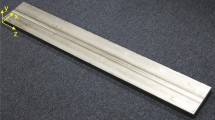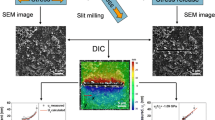Abstract
This paper describes the use of slitting to form a two-dimensional spatial map of one component of residual stress in the plane of a two-dimensional body. Slitting is a residual stress measurement technique that incrementally cuts a thin slit along a plane across a body, while measuring strain at a remote location as a function of slit depth. Data reduction, based on elastic deformation, provides the residual stress component normal to the plane as a function of position along the slit depth. While a single slitting measurement provides residual stress along a single plane, the new work postulates that multiple measurements on adjacent planes can form a two-dimensional spatial map of residual stress. The paper uses numerical simulations to develop knowledge of two fundamental problems regarding two-dimensional mapping with slitting. The first fundamental problem is to estimate the quality of a slitting measurement, relative to the proximity of a given measurement plane to a free surface, whether that surface is the edge of the original part or a free surface created by a prior measurement. The second fundamental problem is to quantify the effects of a prior slitting measurement on a subsequent measurement, which is affected by the physical separation of the measurement planes. The results of the numerical simulations lead to a recommended measurement design for mapping residual stress. Finally, the numerical work and recommended measurement strategy are validated with physical experiments using thin aluminum slices containing residual stress induced by quenching. The physical experiments show that two-dimensional residual stress mapping with slitting, under good experimental conditions (simple sample geometry and low modulus material), has precision on the order of 10 MPa. Additional validation measurements, performed with x-ray diffraction and ESPI hole drilling, are within 10 to 20 MPa of the results from slitting.




















Similar content being viewed by others
References
Prime MB (2001) Cross-Sectional Mapping of Residual Stresses by Measuring the Surface Contour after a Cut. J Eng Mater Technol 123:162–168
Hill MR, Olson MD (2014) Repeatability of the Contour Method for Residual Stress Measurement. Exp Mech 54:1269–1277
Robinson JS, Tanner DA, van Petegem S, Evans A (2012) Influence of Quenching and Aging on Residual Stress in Al–Zn–Mg–Cu alloy 7449. Mater Sci Technol 28:420–430
Ohms C, Wimpory RC, Katsareas DE, Youtsos AG (2009) NET TG1: Residual Stress Assessment by Neutron Diffraction and Finite Element Modeling on a Single Bead Weld on a Steel Plate. Int J Press Vessel Pip 86:63–72
Bouchard PJ (2009) The NeT Bead-on-plate Benchmark for Weld Residual Stress Simulation. Int J Press Vessel Pip 86:31–42
Smith DJ (2013) Deep Hole Drilling, in Practical Residual Stress Measurement Methods, Ch. 3, pp 65–87, John Wiley & Sons, West Sussex, UK
Hill MR (2013) "The Slitting Method", in Practical Residual Stress Measurement Methods, Ch. 4, pp 89–108, John Wiley & Sons, West Sussex, UK
Olson MD, Hill MR, Clausen B, Steinzig M, Holden TM (2015) Residual Stress Measurements in Dissimilar Weld Metal. Exp Mech 55:1093–1103
Upshaw D, Steinzig M, Rasty J (2011) Influence of Drilling Parameters on the Accuracy of Hole-Drilling Residual Stress Measurements. Engineering Applications of Residual Stress 8:95–109
Pagliaro P, Prime MB, Swenson H, Zuccarello B (2010) Measuring Multiple Residual Stress Components using the Contour Method and Multiple Cuts. Exp Mech 50(2):187–294
Wong W, Hill MR (2013) Superposition and Destructive Residual Stress Measurements. Exp Mech 53:339–344
Lee MJ, Hill MR (2007) Intralaboratory Repeatability of Residual Stress Determined by the Slitting Method. Exp Mech 47:745–752
Prime MB (1999) Residual stress measurement by successive extension of a slot: The crack compliance method. Applied Mechanics Review 52:75–96
Lee MJ, Hill MR (2007) Effect of Strain Gage Length When Determining Residual Stress by Slitting. J Eng Mater Technol 129:143–150
Albert A (1972) Regression and the Moore-Penrose Pseudoinverse. Elsevier, New York
Prime MB, Hill MR (2006) Uncertainty, Model Error, and Order Selection for Series-Expanded, Residual-Stress Inverse Solutions. J Eng Mater Technol 128:175
Prime MB, Newborn MA, Balog JA (2003) Quenching and Cold-work Residual Stresses in Aluminum Hand Forgings: Contour Method Measurement and FEM Prediction, in Materials Science Forum, pp. 435–440
Hill MR, Dewald AT, Rankin JE, Lee MJ (2005) Measurement of Laser Peening Residual Stresses. Mater Sci Technol 21:3–9
Hill MR, VanDalen JE (2008) Evaluation of Residual Stress Corrections to Fracture Toughness Values. J ASTM Int 5:1–11
Schajer GS, Prime MB (2006) Use of Inverse Solutions for Residual Stress Measurement. J Eng Mater Technol 128:375–382
Rankin JE, Hill MR (2003) Measurement of Thickness-average Residual Stress Near the Edge of a Thin Laser Peened Strip. J Eng Mater Technol 125:283–293
Cheng W, Finnie I (2007) Measurement of Through-Thickness Residual Stress in Residual Stress Measurement and the Slitting Method, Ch. 7, pp 103–116, Springer Science + Business Media, LLC., New York
Abaqus/Standard (2010) Version 6.10, Providence, RI, USA
Prime MB (2003) Experimental Procedure for Crack Compliance (Slitting) Measurements of Residual Stress, Los Alamos National Laborary Report (LA-UR-03-8629)
Hill MR, Lin WY (2002) Residual Stress Measurement in a Ceramic-Metallic Graded Material. J Eng Mater Technol 124:185
Aydıner CC, Prime MB (2013) Three-Dimensional Constraint Effects on the Slitting Method for Measuring Residual Stress. J Eng Mater Technol 135(3):031006
Cheng W, Finnie I (2006) Residual Shear Stresses and K II Computation,” in Fracture of Nano and Engineering Materials and Structures, E. E. Gdoutos, Ed. Springer Netherlands, 423–424
Steinzig M, Ponslet E (2003) Residual Stress Measurement using the Hole Drilling Method and Laser Speckle Interferometry: Part I, Experimental Techniques, pp. 43–46
Robinson JS, Tanner DA, Truman CE, Paradowska AM, Wimpory RC (2012) The Influence of Quench Sensitivity on Residual Stresses in the Aluminium Alloys 7010 and 7075. Mater Charact 65:73–85
Olson MD, Hill MR (2015) A New Mechanical Method for Biaxial Residual Stress Mapping. Exp Mech 55:1139–1150
Acknowledgements
The authors acknowledge financial support from the Electric Power Research Institute, Materials Reliability Program (Paul Crooker, Senior Technical Leader), and technical support from Daniel Goldin and Kyler Steele (undergraduate student researchers at UC Davis). Special thanks to Professor Jeremy Robinson (University of Limerick) for the x-ray diffraction measurements and Adrian DeWald (Hill Engineering, LLC) for the EPSI hole drilling results presented in this paper.
Author information
Authors and Affiliations
Corresponding author
Rights and permissions
About this article
Cite this article
Olson, M.D., Hill, M. Two-Dimensional Mapping of In-plane Residual Stress with Slitting. Exp Mech 58, 151–166 (2018). https://doi.org/10.1007/s11340-017-0330-y
Received:
Accepted:
Published:
Issue Date:
DOI: https://doi.org/10.1007/s11340-017-0330-y




